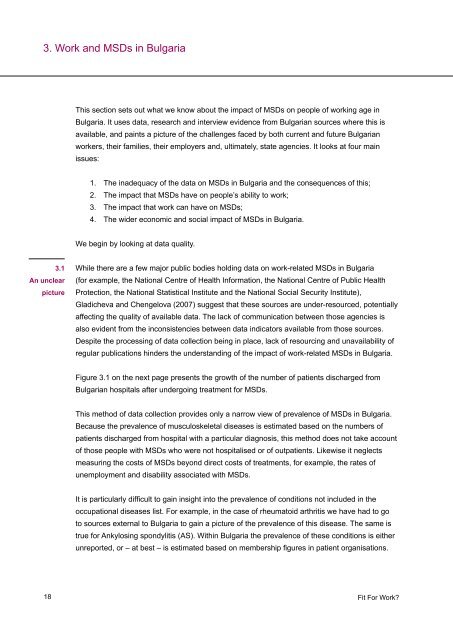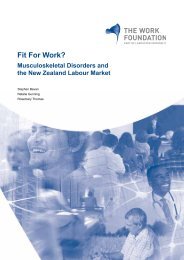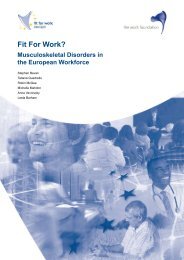FfW Bulgarian report (English language) - Fit for Work Europe
FfW Bulgarian report (English language) - Fit for Work Europe
FfW Bulgarian report (English language) - Fit for Work Europe
Create successful ePaper yourself
Turn your PDF publications into a flip-book with our unique Google optimized e-Paper software.
3. <strong>Work</strong> and MSDs in Bulgaria<br />
3.1<br />
An unclear<br />
picture<br />
18<br />
This section sets out what we know about the impact of MSDs on people of working age in<br />
Bulgaria. It uses data, research and interview evidence from <strong>Bulgarian</strong> sources where this is<br />
available, and paints a picture of the challenges faced by both current and future <strong>Bulgarian</strong><br />
workers, their families, their employers and, ultimately, state agencies. It looks at four main<br />
issues:<br />
1. The inadequacy of the data on MSDs in Bulgaria and the consequences of this;<br />
2. The impact that MSDs have on people’s ability to work;<br />
3. The impact that work can have on MSDs;<br />
4. The wider economic and social impact of MSDs in Bulgaria.<br />
We begin by looking at data quality.<br />
While there are a few major public bodies holding data on work-related MSDs in Bulgaria<br />
(<strong>for</strong> example, the National Centre of Health In<strong>for</strong>mation, the National Centre of Public Health<br />
Protection, the National Statistical Institute and the National Social Security Institute),<br />
Gladicheva and Chengelova (2007) suggest that these sources are under-resourced, potentially<br />
affecting the quality of available data. The lack of communication between those agencies is<br />
also evident from the inconsistencies between data indicators available from those sources.<br />
Despite the processing of data collection being in place, lack of resourcing and unavailability of<br />
regular publications hinders the understanding of the impact of work-related MSDs in Bulgaria.<br />
Figure 3.1 on the next page presents the growth of the number of patients discharged from<br />
<strong>Bulgarian</strong> hospitals after undergoing treatment <strong>for</strong> MSDs.<br />
This method of data collection provides only a narrow view of prevalence of MSDs in Bulgaria.<br />
Because the prevalence of musculoskeletal diseases is estimated based on the numbers of<br />
patients discharged from hospital with a particular diagnosis, this method does not take account<br />
of those people with MSDs who were not hospitalised or of outpatients. Likewise it neglects<br />
measuring the costs of MSDs beyond direct costs of treatments, <strong>for</strong> example, the rates of<br />
unemployment and disability associated with MSDs.<br />
It is particularly difficult to gain insight into the prevalence of conditions not included in the<br />
occupational diseases list. For example, in the case of rheumatoid arthritis we have had to go<br />
to sources external to Bulgaria to gain a picture of the prevalence of this disease. The same is<br />
true <strong>for</strong> Ankylosing spondylitis (AS). Within Bulgaria the prevalence of these conditions is either<br />
un<strong>report</strong>ed, or – at best – is estimated based on membership figures in patient organisations.<br />
<strong>Fit</strong> For <strong>Work</strong>?







